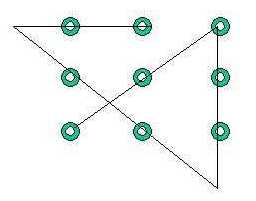"Outside the Box": Thinking Outside the Cliché
In my continuing efforts to avoid the temptation of blogging on the upcoming confidence motions, I'm going to examine a phrase that recently came up in my online activities.
I happen to sit on the committee that decides who gets put on the Red Ensign blogroll. Recently one rejected applicant tried to get the committee to change its mind by exhorting us to "think outside the box."
Pretty much everyone on the committee groaned at this. Most of us at the Brigade tend to dislike corporate jargonisms and catchphrases, and "thinking outside the box" is a perfect example of a phrase that became meaningless through overuse and underapplication.
Nowadays the phrase tends to be used in the sense of "Lower your standards" or "Forget about the rules" or "Do something creative." I suspect it's because people have only a vague idea of the concept and the way it's supposed to be applied.
 According to the Word Origins site, the phrase came from a 1970s-era management exercise, in which managers were challenged to connect the dots in a 3x3 square using only 4 lines. As you can see, the solution does involve drawing the line "outside the box" -- and thus the phrase was born.
According to the Word Origins site, the phrase came from a 1970s-era management exercise, in which managers were challenged to connect the dots in a 3x3 square using only 4 lines. As you can see, the solution does involve drawing the line "outside the box" -- and thus the phrase was born.Revisiting the application, I think I can point out a couple of the characteristics of "outside-the-box" thinking that people have either forgotten or ignored over the years. By doing so, we can put a bit more meaning into it and make it into more than a meaningless slogan.
First, "outside-the-box" thinking doesn't ignore the rules. In the original exercise, nowhere do the instructions specifically state to stay within the implied box. Instead, the "box" is an implied assumption of the puzzle-solver based on the pattern of the dots. The trick is to identify what are "rules" and what are "assumptions."
This is one of the problems with applying "outside-the-box" thinking: too often we find out about the "rules" after we do the thinking. As in: "no, you can't buy brand X software because the boss has a deal with vendor Y."
The trick, then, is to know what the rules are before you work on the problem, and then differentiate between the rules and the assumptions: "Does vendor Y carry a software application that brand X software handles? If not, then buying brand X is still a solution."
Second, "outside-the-box" thinking should surprise people. This should go without saying, since the solution should be something no one has thought of before. But the phrase's deterioration into cliché has caused us to forget that; the boss's exhortation to "think outside the box" has the implied meaning "Come up with something I like." Which pretty much defeats the purpose of the exercise.
Much of the surprise will lie in the actual realization that what was thought of as an unbreakable rule was actually an assumption. The blogosphere's takedown of CBS News during Rathergate is an example of "outside-the-box" thinking because a) everyone believed that the Internet was unreliable as an information source for fact-checking, b) everyone at CBS News believed that they had done their homework, and c) no one believed that the blogosphere could create buzz offline. These were all reasonably strong assumptions -- but they were assumptions all the same.
Finally, the key to true "outside-the-box" thinking is clear understanding of the difference between rule and assumption. In the original exercise, we immediately understand that the "box" is an illusion. In real life, of course, the situation is not quite so cut-and-dried; we have to examine our assumptions and explain, clearly, why the assumption is no longer valid. It's the explanation that tends to defeat people nowadays.
Here's an example of true "outside-the-b0x" thinking: the design of the original Lunar Module for the 1960's Apollo moon program.
Here, the design rules called for the LM had to be super-light.
The problem was that the viewing windows were too heavy, and couldn't be made lighter without seriously compromising the structural integrity of the spacecraft.
A conventional approach would have been to persuade NASA to change the design rules so that the LM didn't have to be so light.
However, a different solution was reached when the designers realized a convention: they'd assumed the astronauts inside the LM would be sitting down when they landed on the moon.
This led to the solution: remove the seats. Not only did they reduce the weight of the seats, but the fact that the astronauts were standing up reduced the surface volume of the viewing windows so that they could be lighter. But this was a such a radical re-thinking of conventional spacecraft design that it required a clear explanation to NASA.
My point in all of this? "Thinking outside the box" may be a cliché now, but it doesn't have to be, once people understand what's actually involved.
Plus, it sure beats catching premature election fever ...





<< Home